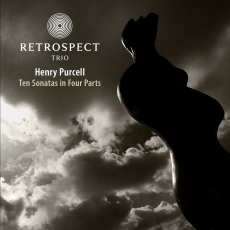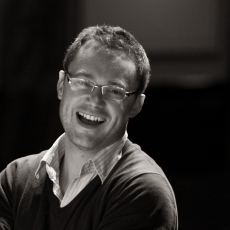Purcell: Ten Sonatas in Four Parts - IRR
Retrospect Ensemble is a new period-instrument group formed by the organist and harpsichordist Matthew Halls, who was latterly director of the King's Music (Robert King having been unavoidably detained). According to its biography, Retrospect can configure itself all the way up to a full classical orchestra, but this outing sees it in small chamber mode, consisting of only two violins, a viola da gamba and Halls on harpsichord and organ. The harpsichord is a copy of the late seventeenth-century Grimaldi instrument in the Nürnberg Museum. Grimaldi instruments are famous for their elaborate decoration and it was interesting to see in the booklet photograph that even in the modern copy (by Malcolm Greenhalgh) the white keys are decorated with beautiful black inlays.
One of the two violinists is the excellent Sophie Gent (whom I had long imagined to be French or French-Canadian, but turns out to be my countrywoman, born and initially educated in Perth, Western Australia). Gent is very much of the ‘chin off' school of Baroque violin playing founded by Sigiswald Kuijken. On this recording, she plays a Januarius Gagliano violin from 1732. The second violinist, Matthew Truscott, was unfamiliar to me but has played with some of the leading English and European Baroque orchestras and is now one of the leaders of the Orchestra of the Age of the Enlightenment. The viola da gamba is a 1712 Barak Norman lent for this recording by a most worthwhile charity: the Benslow Musical Instrument Load Scheme. It is played by Jonathan Manson, one of the founder members of the gamba consort Phantasm, who produced a revelatory Avie recording of the Bach Viola da gamba Sonatas with Trevor Pinnock a few years ago.
For their first recording, Retrospect's choice of Purcell's Ten Sonatas in Four Parts is inspired. They are works of the highest invention but are still too little known even to lovers of Baroque chamber music. Purcell self-consciously wrote the works in the Italian style, but the harmonic twists and ingenious counterpoint (including even triple inverted counterpoint in Sonata No. 9, the so-called ‘Golden Sonata') were all his own. In fact, as Halls points out in the booklet essay, the Italian models Purcell copied were not, in fact, the latest ones (for example by Legrenzi and Corelli) but those of the slightly earlier generation of Vitali and Colista. This is shown by the fact that they are true sonatas à tre, with the gamba part fully developed (the keyboard is the fourth part), not the more fashionable sonatas à due, where the gamba (or cello) is simply part of the continuo accompaniment to the two virtuoso treble instruments, usually violins. The denser texture suited Purcell well and every now and then shades of his magnificent Fantazias can be heard, particularly when Halls plays the organ rather than the harpsichord.
Retrospect play these richly rewarding works with precision, verve and perfect sensibility, aided by a startlingly crisp recorded sound from Linn. For many listeners, the highlight will be their gravely beautiful rendering of the chaconne-based Sonata No. 6, but there are delights and passages of utter sublimity throughout; for example, Retrospect's hushed yet sinewy performance of the opening Grave of Sonata No. 3.
Highly recommended.

